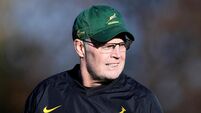The future? Gene-edited athletes, eSports and the end of contact sport

The first of three issues that came to mind is gene doping in sport.
Gene therapy is a means of manipulating genes in order to identify, prevent, and treat diseases. It can also be adapted for non-therapeutic use and namely to enhance performance in sport. Put simply, gene doping may be a very 21st-century means of cheating in sport.
The World Anti-Doping Agency (WADA) has been aware of gene doping’s potential since 2002 and banned it the following year.
At that time, gene therapy was costly and experimental. Few athletes could realistically avail of it and it carried significant health risks.
However, over the last 15 years, the science has evolved rapidly and its potential adaptation to sport presents a real risk into the future for anti-doping authorities.
In January, WADA also had to ban gene editing. The use of gene editing for sport enhancement purposes was outlined last year in an article in the New Scientist.
Gene editing has the potential to alter DNA in existing genes. It can temporarily boost or switch off the activity of a particular gene, even in specific tissues such as muscle. The benefits for athletes is obvious.
The burden for WADA is that such editing is undetectable, even in blood tests. In short, even though it has banned gene editing, WADA has, as of yet, no means of enforcing that ban.
So, is the future of sport one between genetically modified athletes? Indeed, is this already happening?

One way to approach this issue might be not to ban it, but simply to mandate that,
in order to compete, all athletes declare their use of any genetic enhancement and then leave it up to the public, sponsors and TV companies to decide whether this is the type of sport they want to financially support or allow their children to take part in?
Maybe the future of athletics will soon be fourfold in classification: Male, female, intersex, and genetically modified?
The second area of note in the future of sport relates to contact sports.
Recent reports from the various rugby union leagues in both the northern and southern hemispheres have spoken about expansion into the United States.
The commercial potential for sport in the US is huge, but do contact sports have a future there?
Concussion or brain injury fears has affected participation rates in American football at all levels and moves to prohibit tackling at youth level in the sport are gathering pace.
Moreover, in the US, the NFL and the NCAA, which administers college sport, have paid out millions of dollars in class-action settlements taken by retired players, who claim playing contact sports at college or for a team in the NFL led to them suffering chronic, debilitating brain disease in later life.
The NCAA continues to face an avalanche of litigation relating to the link between playing football and players suffering brain trauma, known as chronic traumatic encephalopathy (CTE), a degenerative neurological disease caused by repeated head trauma.
What is said to be America’s first trial directly to litigate the link between American football and CTE takes place in Dallas next month.
In Ploetz v NCAA, the widow of a former elite college football player will claim that the NCAA, as the organiser of the football games in which her husband sustained his injuries, is legally responsible for his subsequent, premature death.
If the plaintiff succeeds, the ruling may change the way the NCAA regulates football but also the way the game is played.
The case is of interest here, because Greg Ploetz played from 1968 until his graduation in 1972 for the University of Texas. He didn’t play football after that, but was dogged by
mental and physical health problems throughout his working career as a high school art teacher.
He died in 2015 and his brain was donated to a Boston University lab specialising in CTE research. It classified Ploetz’s brain at the most severe stage four CTE level.
Former #Texas lineman Greg Ploetz has passed away. Battled mixed dementia late in life. http://t.co/RyQ05qlIam pic.twitter.com/zO7Kw5ivAm
— Concussion Legacy Foundation (@ConcussionLF) May 15, 2015
World Rugby is acutely aware of the dangers of repeated concussion and head trauma. It continuously monitors and commissions evidence-based research to inform itself on how to better risk-manage its sport for the benefit of all who play it.
The danger for rugby is that, despite rule changes on high tackles and the like, the risks inherent in the sport mean that in 20 or 30 years’ time, Ploetz-like, chronic brain injury in players will lead to chronic and costly litigation problems for the sport.
World Rugby is aware of its duty of care in this regard, but all must play a part, including current, elite players.
Recent comments by the retiring England international James Haskell that the game is gone soft are unhelpful.
One look at Ploetz’s brain scans, filed as part of his wife’s litigation, should be enough to educate any current rugby player that concussion regulation is not soft, it’s serious.
Based on what is happening in the US and elsewhere, it may be that the future of sport includes yet another category: Male, female, intersex, genetically modified and, for contact sports, a category of persons who have agreed to sign legal waivers in order to play.
The third prediction relates to the fact that technological developments, wider internet access and the rise of social media has changed the way we access news, watch TV, purchase music and even communicate with each other. This is particularly the case for the first digitally native generations.
Sport is not immune to the changes involved in such digital disruption.
Not only will the next decade see social media companies begin to bid for the financial lifeblood of professional sport — TV broadcasting deals — they will also attempt to change the way we view and “consume” sport.
On the field, we will also see the emergence of shorter forms of established sports: Three on-three basketball, 100-ball cricket, etc, as all sports battle decreasing attention and advertising spans.
Developments in virtual reality will see the rise of competitive gaming and eSports, already a billion-dollar industry globally.
This may well see a sixth classification for sport: Male, female, intersex, genetically modified, contact, and virtual sports participants.
None of my professional predictions — that in the next decade or so the players we go to watch and the games they play will be very different to today’s — may well turn out to be true.
Personally, my preference for the next decade would be a first county championship for my club Doon and an All-Ireland in the hurling for Limerick (in that order).
Because, as it always has been in sport, it’s not the despair of the past failures that gets you; it’s the hope for future success and no amount of gene editing or social media tech will ever change that.












